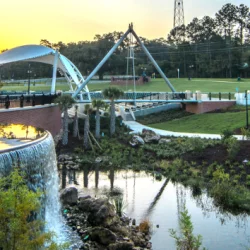Steel Buildings and the Environment
As we strive to improve our carbon footprint the need to find more sustainable materials is of vital importance. This is especially true in the construction industry. The use of unsustainable low cost wood for constructing buildings is no longer a viable option. This has caused construction companies to look to alternative, more sustainable materials that are suited for construction. The favoured material is currently steel. First and foremost steel is a very strong material which is highly cost efficient for many reasons.
Advantages of Steel
Environmental
There are some key reasons as to why steel has become such as popular building material since the 20th century. Since the introduction of computer aided design, much more complex designs can be achieved with materials such as steel. This has greatly improved the usability of steel for a much wider range of applications. One of the key benefits of steel over materials such as wood is steels environmental properties. Steel is a great material when there is a need to reduce wastage. Steel is 100% recyclable so any excess materials created in manufacture can be recycled without degrading the quality of the material.
This also means that if a building is no longer required it can be fully recycled and reused in another capacity. Steel can uniquely be recycled continuously into first-rate steel without any quality degradation making it a highly reusable resource. In the construction industry this is of vital importance when trying to create long lasting buildings.
Steel is also a very efficient material to produce. Its component parts of Iron and Carbon are very abundant making it a sustainable resource and the emissions created in the manufacturing process are very small when compared to other construction materials. The manufacturing process is ever being improved and in May 2013 chemists at MIT have developed methods to produce steel without carbon dioxide as a by product which makes steel a much more attractive material for companies concerned about manufacturing emissions.
Energy Efficiency
Steel is a very energy efficient material it can allow for much higher insulation values than that of wood. Unlike wood it also does not expand or contract to any changes in humidity. Insulated steel framed buildings are likely to save 30 percent in energy costs, which in turn will help to reduce energy costs.
Flexibility
Steel may become a much more common building material as its carbon footprint is reduced. It is superior to timber in that it can be manufactured to any size making it ideal for anything from domestic housing to the tallest skyscrapers. In comparison to timber steel can be made in many more specifications, which can expand its potential uses. It is not uncommon for steel buildings to be extended and steel can be designed to easily allow for add-ons or expansions. Steel can be designed and made into a variety of lengths and thicknesses it makes it very flexible for almost any building type. This can range from commercial warehousing or large Industrial Units to domestic steel buildings such as garages or workshops.
Cost
The cost of steel is also lower than that of brickwork or masonry making it a much more cost effective material. The sustainability of the material means that steel remains at a very constant price with little to no fluctuation in price. The speed in which steel can be installed also means that labour costs can be reduced which can cut down overall related costs. As previously mentioned the lack of waste products means that no material is wasted and can be recycled saving on production costs.
Safety and Durability
Steel has many benefits over other materials. It has one of the highest strength to weight ration of any construction material. Its durability will stop it from warping or expanding over time. Its properties make it fire resistant and resistance to termites and mold. Additionally it is a well grounded material making it less likely to be struck by lightning. Steel framed housing is also becoming popular due to its superior air quality over wooden built housing. Wood can emit Volatile Organic Compounds which can have adverse effects after prolonged exposure. Steel is known to emit a much lower amount of VOCs making it a safer alternative building material.
Steel is a very versatile material. Its versatility and continued improvements on reducing its production emissions should make steel a popular building material for the foreseeable future
Simon Moore is the MD of Midbrook Steel Buildings based in the UK. Midbrook provide commercial, industrial and agricultural steel buildings for many different purposes. Visit www.midbrooksteelbuildings.co.uk today for further information about the company and their products.
More to Read:
Previous Posts:




